Is any business better than no business, or is a better business better than any business?
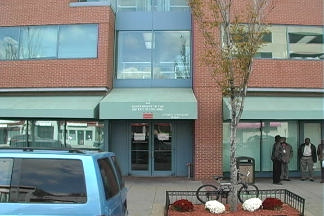 The two office buildings constructed by the H Street CDC are leased by the DC Government. The only spillover economic development generated by these buildings has been one, sometimes two, hot dog carts. A significant number of the clients served by the offices based in these buildings contribute to perceptions of disorder on the H Street corridor. Photo from A9.
The two office buildings constructed by the H Street CDC are leased by the DC Government. The only spillover economic development generated by these buildings has been one, sometimes two, hot dog carts. A significant number of the clients served by the offices based in these buildings contribute to perceptions of disorder on the H Street corridor. Photo from A9.I have always been frustrated by what I call the "Well, it's better than a parking lot" or "It's better than nothing" attitudes about "business development" in inner city neighborhoods.
The first refers to people's attitudes expressed a few years ago about Station Place, the big office building looming over the H Street neighborhood that is completely disconnected from the neighborhood and therefore unable to contribute much in the way of patronage to revitalize the adjoining commercial district.
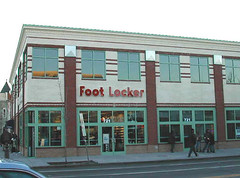 Building at 8th and H Streets NE. The "second" floor is not real.
Building at 8th and H Streets NE. The "second" floor is not real.Similarly, people refer to chain businesses or buildings like the Autozone store or the building constructed by the H Street CDC at 8th and H as better than nothing.
As I have argued ad infinitum over the years, it really matters what you build, and if you ignore the precepts of urban design and/or successful commercial district revitalization when you construct something new or recruit new businesses to your commercial district, the reality is very little ends up being contributed to improving the commercial district.
I think that it's easy to see this on H Street NE. When you count the lease payments, as much as $200 million of federal and city funds have been expended on H Street Connection, the two office buildings on the 600 block, in three "new construction" rowhouse developments spanning about 15 years, the Autozone, and 721-727 H Street NE, yet fundamentally little has improved in the commercial district until recently, and not as a result of these particular efforts.
I raise this because the H Street CDC's current newsletter takes three over-sized pages to excoriate ANC6A for their campaign to get the Zoning Regulations enforced regarding carryouts and fast-food establishments being located in commercial districts. (To the best of my knowledge, this newsletter is not available online.)
I have written plenty about how sit-down restaurants are essential to thriving commercial districts. But carryouts are not sitdown restaurants, and they don't provide the experiences and amenities necessary to build patronage and sampling and change within a commercial district. ("Richard's Rules for Restaurant-Driven Revitalization (Updated)")
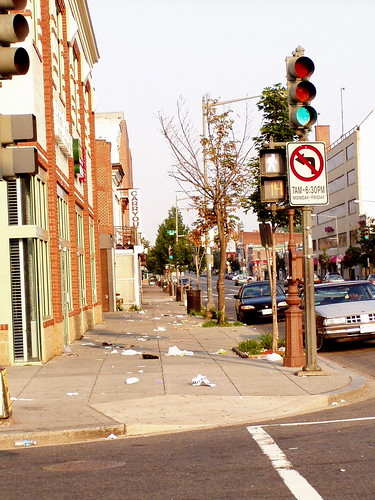 721-727 H Street NE, Washington, DC. This HSCDC building was constructed in part with money from the DC Department of Housing and Community Development, HUD, the Federal Home Loan Bank of Atlanta, and the Local Initiatives Support Corporation. Photo by Elise Bernard.
721-727 H Street NE, Washington, DC. This HSCDC building was constructed in part with money from the DC Department of Housing and Community Development, HUD, the Federal Home Loan Bank of Atlanta, and the Local Initiatives Support Corporation. Photo by Elise Bernard. The CDC leased space to a fast food establishment at 721 H Street NE, even after being informed that a special exception from Zoning Regulations would be necessary. When they did not seek such, and the granting of a certificate of occupancy was successfully challenged, and the Blimpies closed in the interim, the CDC chose to criticize the ANC, rather than to accept responsibility for their failure to adhere to the Zoning Regulations.
Subsequently, the ANC or other groups have challenged three other certificates of occupancy granted to establishments under this provision. One of the establishments received a restaurant license, yet they refuse to install tables and chairs, which are definitional requirements.
The CDC's newsletter criticizes the actions of neighborhood organizations attempting to improve the commercial district, by implying that the local organizations are trying to harm the aspirations of minority entrepreneurs, rather than addressing fundamental issues about how to grow and improve the commercial district.
When the CDC told the ANC in 1999, that they were going to improve the retail district (through the demolition of 4 historic buildings and the new construction of a new one-story ugly building) they said they would provide a:
"...well designed retail space that will attract a community desirable retailer and will improve the quality of retail in the community."
As it turns out, these "desirable retailers" are an athletic shoe store and a Blimpies Sub Shop franchise (and one vacancy). At the time the building was constructed, within one block of the site there were four other chain shoe stores–three sell athletic shoes exclusively.
Similarly, while it is true that the Blimpies offered seats and a restroom, the food items offered by this sub shop duplicate the menus of many of the sixteen other carryouts on the H Street corridor extant at the time of construction.
Blimpies is not the kind of "restaurant" that gives residents an opportunity to enjoy a quality sit- down meal in a venue suitable for entertaining friends or out-of-town guests. At the time the building was constructed there were only four sit-down restaurants on the corridor–one being a Popeyes chicken franchise outlet with plexiglass barriers protecting the cashiers, and another having only six seats.
Today, the H Street commercial district has no card shop, no bakery, no bookstore, no photo or copy shop, no ice cream shop, no office supply store, few if any home furnishings stores, and few nonbank financial services other than payday loans and check cashing joints.
[Since the time when some of the above text was written (June 2002) a coffee shop has opened, as well as three taverns, and some new retail (pet supplies, printing).]
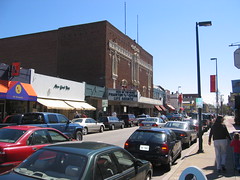 The Carytown commercial district in Richmond has new construction strip shopping centers at one end, but continues on with about 10 blocks of mostly independent retail in traditional-historic buildings. At the other end, the anchor is the Byrd Theater, which shows second run films at cheap prices. Even though there are virtually no vacancies, stores do turn over, and the prevailing rents are about 60% of the asking amount for buildings in the H Street Commercial District. Photo by Steve Pinkus.
The Carytown commercial district in Richmond has new construction strip shopping centers at one end, but continues on with about 10 blocks of mostly independent retail in traditional-historic buildings. At the other end, the anchor is the Byrd Theater, which shows second run films at cheap prices. Even though there are virtually no vacancies, stores do turn over, and the prevailing rents are about 60% of the asking amount for buildings in the H Street Commercial District. Photo by Steve Pinkus.In short, this project did not improve the quality of retail in our community! A "community" development corporation ought to work harder and "walk the walk"–not just "talk the talk"–and truly bring to the commercial district the kinds of neighborhood-serving retail options the community currently lacks.
Better businesses are better than any businesses. And no businesses, sometimes, are better than any business, if the new business doesn't substantively contribute to preferred revitalization objectives.
Also see "Maybe DC can learn that it has something that developers want," "When you don't believe you're really 'world class,' you make bad deals," and "Network effect is no different than the agglomeration effect--thoughts on commercial district revitalization."
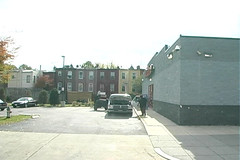 Autozone on H Street NE, constructed by the H Street CDC, although via a for-profit subsidiary and partnership. Photo from A9.
Autozone on H Street NE, constructed by the H Street CDC, although via a for-profit subsidiary and partnership. Photo from A9.As I said once in closing a letter to the editor of the Washington City Paper, "better than cinder block isn't the quality standard with which we should be satisfied."
Index Keywords: urban-revitalization



0 Comments:
Post a Comment
<< Home